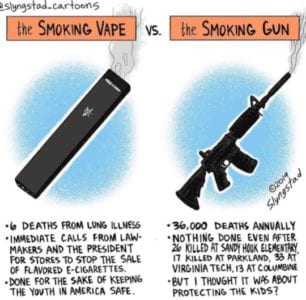Image by Slyngstad
Earlier this month, amid the alarming outbreak of lung injury associated with e-cigarette use in the United States, the Trump Administration announced its intention to ban flavored e-cigarettes. This prompted a response from gun-control advocates, who pointed out that gun deaths vastly outnumber the fatalities attributed to vaping. Shannon Watts, founder of Moms Demand Action, was among those who drew a comparison: “I realize the tobacco lobby didn’t give your campaign $30 million like the NRA did, but gun violence is a national crisis.”
It is indeed overwhelming how gun violence remains an issue largely unattended by authorities, while the country endures mass shootings time and again. Considering that many of the victims of gun violence are children and teenagers —just like those of e-cigarettes—, it is easy to understand where the gun-control advocates are coming from. It is a fair point that deaths stemming from gun violence should cause outrage and lead to action just as those caused by e-cigarettes. However, instead of framing this issue as an opposition between gun violence and e-cigarettes, it can be useful to focus on the similarities between the two industries.
 There are many, as activists working on either of those issues would be quick to notice. Perhaps one of the most obvious is the fact that policymaking on both guns and nicotine-delivery products is often driven by money instead of public health considerations. As Shannon Watts points out, it is no secret that the gun lobby pours a lot of money into political campaigns. It is also a known fact that big tobacco invests heavily in lobbying, and that these companies are diving into the e-cigarette business (and the line is getting blurrier by the day, as top executives from big tobacco migrate to vaping). For example, Altria, Marlboro maker, took a 35% stake in Juul last year. Another example is Phillip Morris, which has recently launched IQOS MESH).
There are many, as activists working on either of those issues would be quick to notice. Perhaps one of the most obvious is the fact that policymaking on both guns and nicotine-delivery products is often driven by money instead of public health considerations. As Shannon Watts points out, it is no secret that the gun lobby pours a lot of money into political campaigns. It is also a known fact that big tobacco invests heavily in lobbying, and that these companies are diving into the e-cigarette business (and the line is getting blurrier by the day, as top executives from big tobacco migrate to vaping). For example, Altria, Marlboro maker, took a 35% stake in Juul last year. Another example is Phillip Morris, which has recently launched IQOS MESH).
Besides lobbying, there is also another similarity between advocates’ rhetoric in the two fields: the argument of freedom. The American Vaping Association explicitly says, “With the variety of e-juices out there and levels of nicotine, I have a taste of freedom in my system.” The National Rifle Association also focuses heavily on freedom. Following the Parkland shooting, Wayne LaPierre, NRA’s chief executive, said gun-control activists and the media did not care about schoolchildren. “They want to make all of us less free,” he said. It goes without saying that these claims are questionable, to say the least. On the one hand, nicotine has thousands of kids hooked on e-cigarettes. On the other hand, schoolchildren are now facing lockdown drills at school, which require students and teachers to stay put in a classroom with locked doors, closed windows, lights turned off, and blinds drawn.
Finally, there is the fact that children and teenagers are among the biggest victims of both gun violence and e-cigarettes. Gun violence has kids all over the country anxious about active shooters. E-cigarettes have kids in the hospital because of a mysterious lung injury.
It is understandable that activists against gun violence are angry at the government’s inaction when it comes to regulating guns. Surely, most of the activists against big tobacco empathize with their frustration. However, regulating e-cigarettes will be a victory nevertheless. In the end, it will protect our children and teenagers, which is what activists working on either cause – and against quite similar opponents – want.



